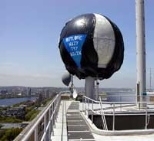The campus is under hack attack. It's a rite of spring.
Four hacks have sprung up on campus since last Thursday, providing relief from the intensity of finals. Hacks are nondestructive pranks or practical jokes that challenge the perpetrators and amuse the MIT community and often the rest of the world. The people responsible are seldom identified.
"We're in the midst of a flurry," said David Barber of the Safety Office, head of the hack evaluation and removal team. "The period between finals and Commencement is usually pretty busy." Other popular times for hacks are April Fool's Day, the beginning of the fall semester and Halloween.
Yesterday morning, strollers along Killian Court observed a "crack" in the Great Dome topped by a weight labeled "48 units," likening a student's academic load to the tonnage that falls on Wile E. Coyote and Roadrunner in cartoons.
The crack, made of black polyester fabric, was attached to two aircraft cables and cinder blocks. Steel cables held the weight together and it was secured by four 500-pound-test nylon ropes. The paint was waterproofed with shellac to protect it from the elements.
"We would appreciate if you would leave the hack up until this evening so that there might be an opportunity for the weight on the dome to lighten peoples' spirits," the hackers requested. Mr. Barber, who complied after inspecting the structure, said, "It's one of the best constructed and secured hacks I've ever seen."
Monday morning's hack on the roof of Building 54 did not fare as well. The microwave dome was wrapped in black plastic with the message "Outlook Hazy/Try Again" printed across the front to resemble the "Magic 8-Ball" fortune-telling toy. It was secured with plastic tubing and nylon cord. "The wind was blowing and it was starting to disintegrate," Mr. Barber said. "We had to take it down for safety reasons."
Early last Thursday, May 17, a Tech Dinghy and purple porpoise sidekick appeared in the water-filled moat surrounding the MIT Chapel. Sailing Master Fran Charles sent members of the sailing team over to retrieve the dinghy along with the porpoise, said to have been a onetime resident of the Baker House dining hall.
Construction workers reportedly saw the hackers skateboard away from the sailing pavilion carrying a sail at about 5am Thursday; the boat itself must have been taken earlier in the night. Mr. Charles said the boat's wire stays had been cut and the fiberglass sides were scratched by the bricks lining the sides of the moat.
The porpoise now resides in Mr. Charles's office.
Also on Thursday, a banner mounted on the Great Dome paid tribute to the late author Douglas Adams. The message was a takeoff on the title of his book So Long and Thanks for All the Fish (the hack had the last word changed to "wit"), part of Mr. Adams' popular Hitchhiker's Guide to the Galaxy series. Mr. Adams died of a heart attack on May 11 at age 49.
Denise Brehm contributed to this story.
A version of this article appeared in MIT Tech Talk on May 23, 2001.









